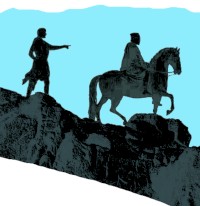About a month ago Ishmael took me to the Viking exhibit at a nice mountainside museum above Salt Lake City. There were quite a few archeological treats, swords, knives spearheads, fetters for binding slaves and various day to day goods, with combs in abundance. A video of a reconstructed long ship and a large model of one were prominently featured as part of the exhibit.
To skip ahead to the inane prologue, a legend that “we are all Vikings” is placed below a cute mulatto babe wearing pink and sporting a winged [bunny ears would have been more appropriate] Viking helmet, as if inviting the Viking in me to drag her off to my hold and sire a behavioral problem for future school teachers…
Two things stick out in my mind that spoke authentically to the grey part of my soul:
That the hole in the roof of a Viking home for the emission of smoke and the admission of light was known as “The wind’s eye,” for I cannot conceive of a North Atlantic mariner, prior to the Age of Sail, failing to be awed by the winds. Ages earlier, in warmer seas, other men who manned oared, open ships, fitted with a single square sail, held the winds in such awe that numerous gods, chief of them Boreas, the North Wind, where deeply imbedded in their cosmology.
In many ways the Argonautica is a Viking tale, down to the presence of a rageful axe-wielding hero who wore a bearskin into battle. It is important, for the preservation of our epic heritage in a realistic context, to not study the hero tales of old in their own separate vacuums, but to regard Achilles in the light of Gilgamesh, Odysseus in the light of Enkidu, to consider Beowulf with a mind appreciative of Jason, to fathom Roland as we would Leonidas, both betrayed by their nations, yet loyal to their code.
The most salient notion I took away from the Viking exhibit was pointed out to me by Ishmael, sitting like a weary giant on a bench before the three dimensional computer display of the Norse conception of the cosmos, a floating image that looked for all the world like a galaxy. No such legend was attached to the politically correct display, but Ishmael, seeming like he had just gained a deep measure of appreciation for the worldview of his Norse ancestors, said, “Look, James, it’s the Milky Way. You know, Ron West has likened Native American cosmology to Quantum physics—why not the Norse? It is as if they knew something that we don’t. How could we really know more? Heck, you tell me where you live that you can’t see the stars at night for the city lights. Our ancestors had to know things we’ve forgotten.”
The Voyage of Argo should be considered in the light of the voyage of Man, to his many destinations, very often at the mercy of the elements and for most of our history helpless before the sea-combing winds.
Along the lines of the galaxy-like map of the Viking cosmos, consider the following interpretations by Varg and his Bride:
Picking up the Runes (Maïeutics, Part II)
Of Lions and Men











